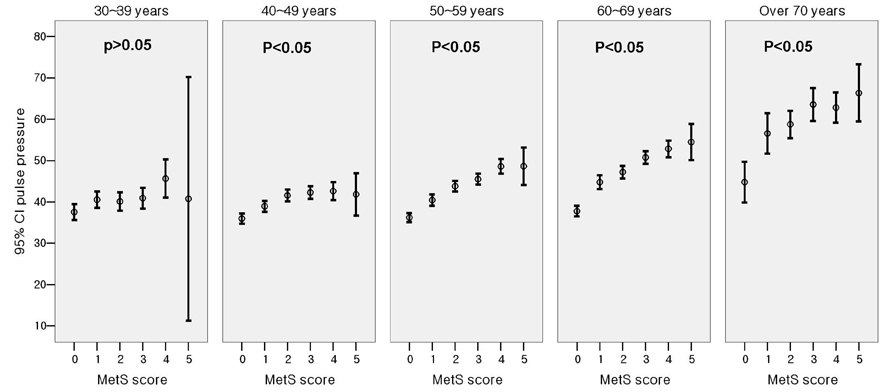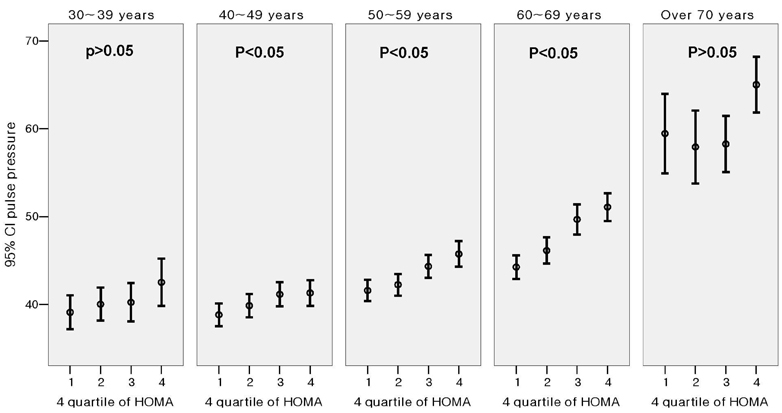Yonsei Med J.
2008 Feb;49(1):63-70.
Increase of Metabolic Syndrome Score is an Independent Determinant of Increasing Pulse Pressure
- Affiliations
-
- 1The Heart Center, Chonnam National University Hospital, Gwangju, Korea. shpark0530@yuhs.ac
- 2Division of Cardiology, Cardiovascular Hospital, Yonsei University College of Medicine, Seoul, Korea.
- 3Cardiovascular Genome Center, Cardiovascular Hospital, Yonsei University College of Medicine, Seoul, Korea.
Abstract
- PURPOSE
The objective of this study was to determine whether the progressive increase of metabolic syndrome (MetS) score, the number of components of MetS, is correlated significantly with increasing pulse pressure (PP). MATERIALS AND METHODS: 4,034 subjects were enrolled from the Cardiovascular Genome Center of Yonsei University (M:F=2344:1690, 55.2 +/- 10.5). Most of the study population were recruited from hypertension clinics, controlled with medications according to JNC7 guidelines. The Asian modified criteria of MetS were applied and MetS score was estimated. The HOMA index for insulin resistance, cholesterol profiles, and anthropometric measurements were assessed. RESULTS: Among 4034 participants, 1690 (41.9%) were classified as MetS. Progressive increase in PP was demonstrated for increasing components of the MetS score. Multiple linear regression analysis with PP as the dependent variable showed that age (beta=0.311, p < 0.001), MetS score (beta=0.226, p < 0.001), male gender (beta=-0.093, p < 0.001) and HOMA index IR (beta=0.033, p=0.03) are significantly associated with PP (R(2)=0.207, p < 0.001). CONCLUSION: The present results from this study demonstrate that increasing MetS score is an independent determinant of increasing PP. The results also demonstrate the independent role of MetS in increasing arterial stiffness and PP.
MeSH Terms
Figure
Reference
-
1. Franklin SS, Khan SA, Wong ND, Larson MG, Levy D. Is pulse pressure useful in predicting risk for coronary heart Disease? The Framingham heart study. Circulation. 1999. 100:354–360.
Article2. Blacher J, Staessen JA, Girerd X, Gasowski J, Thijs L, Liu L, et al. Pulse pressure not mean pressure determines cardiovascular risk in older hypertensive patients. Arch Intern Med. 2000. 160:1085–1089.
Article3. Benetos A, Safar M, Rudnichi A, Smulyan H, Richard JL, Ducimetieère P, et al. Pulse pressure: a predictor of long-term cardiovascular mortality in a French male population. Hypertension. 1997. 30:1410–1415.4. Nichols WW, Nicolini FA, Pepine CJ. Determinants of isolated systolic hypertension in the elderly. J Hypertens Suppl. 1992. 10:S73–S77.
Article5. Grassi G, Giannattasio C. Obesity and vascular stiffness: when body fat has an adverse impact on arterial dynamics. J Hypertens. 2005. 23:1789–1791.
Article6. Czernichow S, Bertrais S, Blacher J, Oppert JM, Galan P, Ducimetèire P, et al. Metabolic syndrome in relation to structure and function of large arteries: a predominant effect of blood pressure. A report from the SU.VI.MAX. Vascular Study. Am J Hypertens. 2005. 18:1154–1160.7. Schillaci G, Pirro M, Vaudo G, Mannarino MR, Savarese G, Pucci G, et al. Metabolic syndrome is associated with aortic stiffness in untreated essential hypertension. Hypertension. 2005. 45:1078–1082.
Article8. Scuteri A, Najjar SS, Muller DC, Andres R, Hougaku H, Metter EJ, et al. Metabolic syndrome amplifies the age-associated increases in vascular thickness and stiffness. J Am Coll Cardiol. 2004. 43:1388–1395.
Article9. Sutton-Tyrrell K, Newman A, Simonsick EM, Havlik R, Pahor M, Lakatta E, et al. Aortic stiffness is associated with visceral adiposity in older adults enrolled in the study of health, aging, and body composition. Hypertension. 2001. 38:429–433.
Article10. Chobanian AV, Bakris GL, Black HR, Cushman WC, Green LA, Izzo JL Jr, et al. Seventh report of the Joint National Committee on Prevention, Detection, Evaluation, and Treatment of High Blood Pressure. Hypertension. 2003. 42:1206–1252.
Article11. Friedewald WT, Levy RI, Fredrickson DS. Estimation of the concentration of low-density lipoprotein cholesterol in plasma, without use of the preparative ultracentrifuge. Clin Chem. 1972. 18:499–502.
Article12. Executive Summary of The Third Report of The National Cholesterol Education Program (NCEP) Expert Panel on Detection, Evaluation, And Treatment of High Blood Cholesterol In Adults (Adult Treatment Panel III). JAMA. 2001. 285:2486–2497.13. Kim HC, Choi KS, Jang YH, Shin HW, Kim DJ. Normal serum aminotransferase levels and the metabolic syndrome: Korean National Health and Nutrition Examination Surveys. Yonsei Med J. 2006. 47:542–550.
Article14. Wilkinson IB, Prasad K, Hall IR, Thomas A, MacCallum H, Webb DJ, et al. Increased central pulse pressure and augmentation index in subjects with hypercholesterolemia. J Am Coll Cardiol. 2002. 39:1005–1011.
Article15. Mahmud A, Feely J. Effect of smoking on arterial stiffness and pulse pressure amplification. Hypertension. 2003. 41:183–187.
Article16. Schram MT, Henry RM, van Dijk RA, Kostense PJ, Dekker JM, Nijpels G, et al. Increased central artery stiffness in impaired glucose metabolism and type 2 diabetes: the Hoorn Study. Hypertension. 2004. 43:176–181.
Article17. Grandi AM, Maresca AM, Giudici E, Laurita E, Marchesi C, Solbiati F, et al. Metabolic syndrome and morphofunctional characteristics of the left ventricle in clinically hypertensive nondiabetic subjects. Am J Hypertens. 2006. 19:199–205.
Article18. Reilly MP, Rader DJ. The metabolic syndrome: more than the sum of its parts? Circulation. 2003. 108:1546–1551.19. Kosch M, Barenbrock M, Kisters K, Rahn KH, Hausberg M. Relationship between muscle sympathetic nerve activity and large artery mechanical vessel wall properties in renal transplant patients. J Hypertens. 2002. 20:501–508.
Article20. Westerbacka J, Seppälä-Lindroos A, Yki-Järvinen H. Resistance to acute insulin induced decreases in large artery stiffness accompanies the insulin resistance syndrome. J Clin Endocrinol Metab. 2001. 86:5262–5268.
Article21. Nagano M, Nakamura M, Sato K, Tanaka F, Segawa T, Hiramori K. Association between serum C-reactive protein levels and pulse wave velocity: a population-based cross-sectional study in a general population. Atherosclerosis. 2005. 180:189–195.
Article22. Ridker PM, Wilson PW, Grundy SM. Should C-reactive protein be added to metabolic syndrome and to assessment of global cardiovascular risk? Circulation. 2004. 109:2818–2825.
Article23. Festa A, D'Agostino R Jr, Howard G, Mykkänen L, Tracy RP, Haffner SM. Chronic subclinical inflammation as part of the insulin resistance syndrome: the Insulin Resistance Atherosclerosis Study (IRAS). Circulation. 2000. 102:42–47.
Article24. Ridker PM, Buring JE, Cook NR, Rifai N. C-reactive protein, the metabolic syndrome, and risk of incident cardiovascular events: an 8-year follow-up of 14 719 initially healthy American women. Circulation. 2003. 107:391–397.
Article25. Sengstock DM, Vaitkevicius PV, Supiano MA. Arterial stiffness is related to insulin resistance in nondiabetic hypertensive older adults. J Clin Endocrinol Metab. 2005. 90:2823–2827.26. Westerbacka J, Yki-Järvinen H. Arterial stiffness and insulin resistance. Semin Vasc Med. 2002. 2:157–164.
Article27. Greenberg J. Antihypertensive treatment alters the predictive strength of pulse pressure and other blood pressure measures. Am J Hypertens. 2005. 18:1033–1039.
Article
- Full Text Links
- Actions
-
Cited
- CITED
-
- Close
- Share
- Similar articles
-
- Brachial-ankle Pulse Wave Velocity in Koreans with the Metabolic Syndrome
- Association of metabolic syndrome with the pulse wave velocity
- Pulse Pressure and Systolic Blood Pressure
- Impact of the Metabolic Syndrome and Its Components on Pulse Wave Velocity
- Obstructive Sleep Apnea and the Metabolic Syndrome




